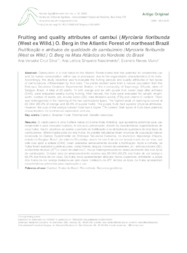Fruiting and quality attributes of cambui (Myrciaria floribunda (West ex Willd.) O. Berg in the Atlantic Forest of northeast Brazil.
Fruiting and quality attributes of cambui (Myrciaria floribunda (West ex Willd.) O. Berg in the Atlantic Forest of northeast Brazil.
Author(s): SILVA, A. V. C. da; NASCIMENTO, A. L. S.; MUNIZ, E. N.
Summary: Cambuizeiro is a fruit native to the Atlantic Forest biome that has potential for ornamental useand for human consumption, either raw or processed, due to the organoleptic characteristics of its fruits. Accordingly, the study objective was to evaluate the fruiting periods and quality attributes of two types of cambuizeiros, differentiated by fruit color. The plants studied were from a natural population from the Embrapa Tabuleiros Costeiros Experimental Station, in the municipality of Itaporanga d?Ajuda, state of Sergipe, Brazil. A total of 20 plants, 14 with orange and six with purple fruit, seven days after anthesis (DAA), were evaluated weekly during fruiting. After harvest, the fruits were evaluated for weight, length, width, number of seeds, pH, soluble solids (SS), total titratable acidity (TTA) and vitamin C content. There was heterogeneity in the ripening of the two cambuizeiro types. The highest peak of ripening occurred at 63 DAA (83.2% of orange and 68.3% of purple fruits). The purple fruits had superior physical attributes. However, the pulp of the orange colored fruits had a higher TTA content. Both types of fruits have potential characteristics for commercial exploration and use.
Publication year: 2020
Types of publication: Journal article
Observation
Some of Embrapa's publications are published as ePub files. To read them, use or download one of the following free software options to your computer or mobile device. Android: Google Play Books; IOS: iBooks; Windows and Linux: Calibre.
Access other publications
Access the Agricultural Research Database (BDPA) to consult Embrapa's full library collection and records.
Visit Embrapa Bookstore to purchase books and other publications sold by Embrapa.

